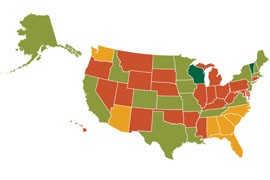Cronkite News has moved to a new home at cronkitenews.azpbs.org. Use this site to search archives from 2011 to May 2015. You can search the new site for current stories.
State’s ‘dropout factories’ decline, but graduation rates still lag nation
WASHINGTON – Arizona posted one of the country’s sharpest declines in so-called “dropout factories” in the last decade, but was still slightly below the national average for high school graduation rates in 2011, according to a recent report.
America’s Promise Alliance said the number of Arizona dropout factories – high schools that graduate fewer than 60 percent of their students – fell from 37 schools in 2002 to 21 of the 394 high schools in the state in 2011.
That 43 percent drop translated into 26,000 fewer students at such schools, the report said.
“Arizona is doing a good job, making good progress, but they have to do more,” said Colleen Wilber, a spokeswoman for America’s Promise Alliance, the Washington-based children’s advocacy organization that released the report.
State education officials had various explanations for the drop.
Tracey Benson, director of communications for the Arizona School Boards Association, said much of the success could be attributed to career and technical schools, which train students in careers that generally do not require post-secondary degrees.
Students in those programs are more likely to graduate because they have a particular goal or career in mind, Benson said.
“The more relevant and engaging we can make school for students … and make them feel that their learning is relevant and is preparing them for what’s next, the more success we’re going to find,” she said.
Struggling schools are also likely to get help. Outside officials may meet with teachers and administrators to inspect the school’s programs, for example, to find specific areas where improvements can be made.
“Schools are not left to languish,” Benson said.
But Sheenae Shannon, communications director for the Arizona Education Association, warned that improvements in graduation rates might not continue into the next decade because the state has drastically cut school funding.
Since 2009, she said, Arizona has cut kindergarten-through-12th-grade funding by more than $1 billion. That has led to larger class sizes, fewer classroom resources and defunded programs, including full-day kindergarten and the vocational training high schools that have helped reduce dropout rates.
“While our dropout rate is going down now, who knows what’s going to happen when Arizona is no longer investing in our future?” Shannon asked.
The director of dropout prevention for the Arizona Department of Education said methods for boosting graduation vary greatly between districts. Jan Brite said it’s difficult to determine the effectiveness of different programs, because it’s hard to know if a student would have dropped out if a program didn’t exist.
But what isn’t hard to determine is the economic impact of dropouts, both on the student and the state, she said. Brite said students who do not get a high school diploma cripple their chances of getting a high-paying job later.
“There’s not an awful lot of jobs out there for an education less than a high school diploma these days,” Brite said.
Arizona had a graduation rate of 77.9 percent in 2011, up from 74 percent in 2003, according to the America’s Promise Alliance report.
When considering the number of dropout factories in a state, the alliance counted only traditional and vocational high schools with 300 or more students enrolled.
Wilber said dropout factories are responsible for the majority of dropouts nationwide, and students in such schools face a harder-than-normal challenge in graduating.
“If you’re already attending a high school where graduation isn’t the norm, you already kind of know what they outcome is going to be,” she said.







